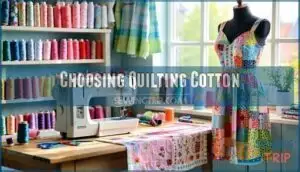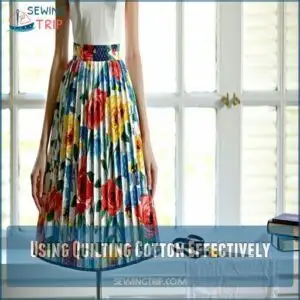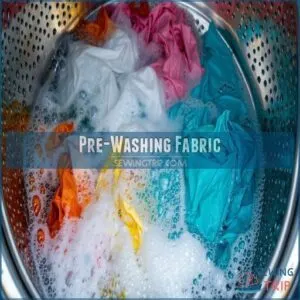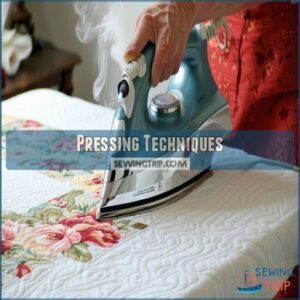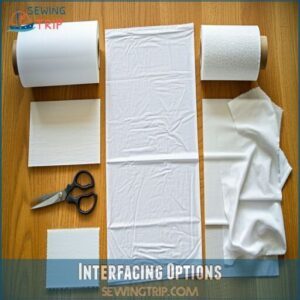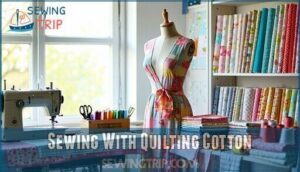This site is supported by our readers. We may earn a commission, at no cost to you, if you purchase through links.
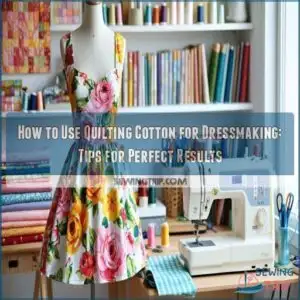
This fabric is sturdy, breathable, and holds bold prints beautifully, but it’s a bit stiff.
Start by pre-washing to prevent shrinking later. Use a universal needle and cotton thread for smooth seams, and always press as you sew—crisp edges make a world of difference.
Quilting cotton works best for structured garments like shirtdresses or skirts. Skip flowy designs; it’s not drapey enough.
Need extra shaping? Add interfacing or darts. It’s like turning a comfy quilt into wearable art—practical and stylish! Ready to explore more tips for sewing success?
Table Of Contents
Key Takeaways
- Always pre-wash your quilting cotton to prevent shrinkage and bleeding, skipping fabric softeners that can interfere with stitching and using a hot iron with steam to press for smooth results.
- Choose structured garment designs like A-line skirts or shirtdresses that complement quilting cotton’s stiffness, avoiding flowy styles that require more drape.
- Select high-quality brands like Robert Kaufman or Hoffman for better texture and durability, and consider Japanese cottons if you’re looking for softness while maintaining structure.
- Use the right tools for the job—an 80/12 universal needle, 50-weight cotton or polyester thread, and proper seam finishing techniques like serging or bias binding to prevent fraying.
Choosing Quilting Cotton
When choosing quilting cotton for dressmaking, think about the fabric’s stiffness, print, and how it suits your garment.
Stick with high-quality brands to avoid rough textures or fabrics that wear out quickly.
Fabric Characteristics
Quilting cotton is a medium-weight fabric known for its firm body and low drape, making it ideal for structured designs.
Perfect for structured designs, quilting cotton’s firm body and low drape transform bold prints into standout, breathable garments.
Its tight weave density enhances print durability and prevents fraying, while the 100% cotton fiber content guarantees breathability.
Watch out for its high shrinkage rate; prewashing is key. Quilting cotton dressmaking thrives on bold prints and creative flair.
Garment Requirements
When planning quilting cotton clothing, think about the fabric’s weight and drape.
Garments like A-line skirts or sleeveless dresses shine with its structure, but avoid designs needing flowy movement.
Consider print scale for bold effects and add a lining for comfort.
Quilting cotton dressmaking works best when garment construction matches the fabric’s firm texture and movement needs, allowing for a good balance of style and comfort.
Brand Selection
When picking quilting cotton, fabric brands matter. Robert Kaufman and Hoffman offer top-tier quality, perfect for dressmaking.
Prefer something softer? Try Japanese Cottons—they’re both durable and luxurious. Budget brands like Michael Miller work too, but always do a durability test before committing.
One should also consider color theory guidance to guarantee visual harmony. With print variety galore, Kaufman vs. Hoffman depends on your style and project needs.
Using Quilting Cotton Effectively
When working with quilting cotton for clothing, understanding its strengths is key.
This fabric’s medium weight and bold prints make it perfect for structured designs like A-line skirts or sleeveless dresses.
Focus on print scale and design placement to highlight patterns effectively—big prints pop on simple garments but can overwhelm detailed designs.
For comfort factors, consider the fabric’s stiffness.
Adding lightweight lining options can enhance the feel against your skin and improve wearability.
Keep in mind that quilting cotton dresses shine when structure is the goal, not flow.
To guarantee longevity, consider using durable fabrics like denim for reinforcement.
Use quilting cotton sewing tips, like balancing bold prints with solids, to create standout pieces.
Experiment, stay creative, and embrace cotton dressmaking techniques to turn quilting cotton into fashionable, functional masterpieces!
Preparing Quilting Cotton
Before you sew with quilting cotton, make sure you prep it properly to avoid surprises later.
Pre-washing, pressing, and choosing the right interfacing can save you headaches and help your project look its best.
Pre-Washing Fabric
Toss your quilting cotton in the wash before sewing—it’s a must!
Prewashing prevents shrinkage surprises and keeps colors from bleeding.
Skip fabric softeners; they can mess with your stitches.
A quick tumble reduces wrinkles, though ironing still helps.
Prewashing also softens the texture, prepping the fabric for dresses and ensuring everything fits perfectly after sewing, which helps prevent bleeding issues.
Pressing Techniques
A good press makes all the difference.
Use a hot iron with steam pressing to smooth quilting cotton, but avoid scorching it—pressing tools like a pressing cloth help prevent shine.
For seam pressing, always press open before stitching across.
Ironing after pre-washing controls fabric shrinkage and preps for interfacing application.
Proper shaping relies on specialized pressing tools for curved seams.
Treat pressing like dressmaking’s secret superhero… it saves projects and is a crucial step in the process, making it a good press that makes all the difference, with the right tools, like a pressing cloth.
Interfacing Options
Pressing’s done? Let’s chat interfacing. Quilting cotton for dresses needs support in spots like waistbands or collars.
Fusible interfacing is quick—just iron it on. Sew-in interfacing offers control, especially for heat-sensitive fabrics. Many sewists find cotton interfacing options particularly useful.
- Choose the right weight: Match interfacing weight to fabric.
- Think alternatives: Muslin or lightweight cotton works.
- Pre-shrink everything: Avoid post-sewing surprises.
Sewing With Quilting Cotton
Sewing with quilting cotton is simple when you’ve got the right tools and techniques.
From picking the perfect thread to using the right needle, a few small choices can make a big difference in your results.
Thread Selection
Choosing the right thread type is key when sewing quilting cotton.
Opt for high-quality polyester or cotton thread with a 50-weight for smooth stitches. Match thread color to your fabric or try contrasting shades for flair.
Many retailers offer quilting cotton thread online. Avoid thick specialty threads—they can jam your sewing machine.
These sewing tips keep your projects sturdy, stylish, and frustration-free!
Needle Choice
Your needle choice can make or break your project!
For quilting cotton, match the needle size and type to the fabric thickness for smooth stitching.
Follow these tips:
- Use a Universal needle, size 80/12, for medium-weight fabrics like quilting cotton.
- Adjust for machine compatibility to avoid skipped stitches.
Consider using specialized cotton needles for best results.
- Test stitch quality on scraps first!
Seam Finishing Techniques
Seams need tidy finishes to prevent fraying and support durability in quilting cotton apparel.
Try serging edges for efficiency or bias binding for a polished look.
French seams work wonders on lightweight projects, while an overcast stitch is versatile.
Pinking shears are a quick fix too.
These sewing techniques make quilting cotton for clothing both practical and professional, following proper sewing guidelines.
Creating Quilting Cotton Garments
You can turn quilting cotton into beautiful garments by choosing designs that match the fabric’s structured feel.
Stick with patterns like skirts or sleeveless dresses to let the fabric’s stiffness work for you.
While avoiding tight sleeves or flowy styles.
Suitable Garment Types
Quilting cotton for clothing shines in garments needing structure.
It’s perfect for cotton dress patterns with bold prints or quilting cotton skirts that hold their shape.
Try:
- Beginner projects like PJ bottoms or simple A-line skirts.
- Statement sleeves that benefit from its stiffness.
- Print showcasing in sleeveless dresses.
Its medium weight provides added structure ideal for certain garments.
Always consider movement requirements when selecting quilting cotton for apparel.
Pattern Adjustments
Pattern adjustments can make or break using quilting cotton for apparel.
With width constraints, you’ll need clever layout tricks—maybe shrink skirt gradients or add pleats.
Grainline matching guarantees your sewing patterns align, especially with bold prints.
Don’t forget ease adjustment, as cotton lacks stretch.
Combining sizes or tweaking seams lets your cotton dress patterns shine with structure and charm.
Construction Tips
Once your pattern adjustments are sorted, focus on smooth construction.
Use stay stitching to prevent stretching and guarantee grainline alignment for a polished fit.
Add fusible interfacing to facings for extra stability.
Understitching keeps seams neat and comfortable.
Remember, quilting cotton’s stiffness makes seam allowances behave, but it’s unforgiving with mistakes—so slow down and enjoy the sewing process!
Frequently Asked Questions (FAQs)
Can I use quilting cotton to make a dress?
Quilting cotton works well for structured dresses like A-line or sleeveless styles.
Its stiffness showcases bold prints beautifully, but avoid flowy designs.
Pre-wash it, check the grain, and enjoy crafting something unique!
Can I use quilting cotton for lining?
For lining, quilting cotton’s stiffness isn’t ideal.
It can feel bulky and restrict movement. Opt for softer, silky fabrics like polyester or rayon.
Save quilting cotton for visible parts where structure is needed.
What can I use quilting cotton for?
Ever think fabric could be a chameleon?
Quilting cotton works for structured skirts, crafty tote bags, bold cushions, or even pajama bottoms.
While it’s stiff, its vibrant prints and durability make creative projects shine.
How much should I pre-wash my quilting cotton fabric?
Pre-wash quilting cotton in warm water with mild detergent, just like you’d wash the finished garment.
This prevents shrinkage surprises later.
Use a gentle cycle, tumble dry low, and press it smooth before cutting.
What are the best seam finishing techniques for quilting cotton?
Think of seam finishing like wrapping a gift—details matter.
Use pinking shears to prevent fraying, or go pro with a zigzag or overlock stitch.
French seams add flair, perfect for quilting cotton’s structured charm.
Are there any special tips for hemming quilting cotton?
You’ll want to press your hem allowance twice for a clean finish.
Use a longer stitch length (3-5mm) to prevent puckering, and add a bit of starch for crisp edges.
How can quilting cotton be waterproofed for outdoor use?
Sarah’s outdoor picnic quilt stays dry thanks to waterproofing spray.
You’ll need to apply spray outdoors (6-8" away), let it dry in full sun for 6-8 hours, then test with water drops.
Beeswax is a natural alternative if you don’t mind stiffness.
What safety considerations are necessary for children’s clothing?
Choose flame-resistant fabrics and avoid loose strings, buttons, or decorative items that could pose choking hazards.
You’ll also want to make certain that drawstrings are short or eliminated entirely, especially around necks and hoods to prevent potential hazards.
How does quilting cotton perform in hot, humid climates?
You’d think quilting cotton would be a nightmare in the tropics, but it’s actually breathable and absorbent.
You’ll find it comfortable in hot, humid climates as it wicks away moisture and allows airflow.
Are organic quilting cottons suitable for sensitive skin?
Yes, organic quilting cottons are ideal for sensitive skin since they’re free from harsh chemicals and pesticides.
They’re softer to the touch and you’ll find them less likely to cause irritation or allergic reactions.
Conclusion
Proudly put your prepped quilting cotton to practical use! You’ve now mastered how to use quilting cotton for dressmaking—from fabric selection to final stitches.
With these techniques, you’ll transform those beautiful prints into wearable garments that showcase your skills. Remember, the right pattern choice and proper preparation make all the difference.
Don’t be afraid to experiment—your sewing journey is unique. Ready your machine, choose your pattern, and create something both beautiful and uniquely yours!
- https://www.reddit.com/r/craftsnark/comments/lxrwwt/why_not_sew_clothes_with_quilting_cotton/
- https://www.thefabricsquirrel.com/post/dressmaking-with-quilting-cotton?srsltid=AfmBOorMw7WJbEakAhNyqUSKUIELAy6WbGZOl-qzO4A-shn8AWzU4Ifh
- https://www.youtube.com/watch?v=5gDiNVnVN8g
- https://sewing.patternreview.com/SewingDiscussions/topic/116404
- https://www.instagram.com/tillybuttons/

